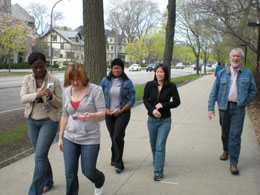
Mark Glaser is traveling this week, but we’re happy to have students from the Medill School of Journalism at Northwestern University filling in as special guest bloggers this week. They are in a class studying “locative media,” a new form of journalism that tells stories via cell phones based on your location. This is the second part of their report; the first part ran on Tuesday.
Once our LoJo team finalized our locative story idea, we had to decide which format and technology worked best. We debated the advantages of driving tours versus walking tours. Driving tours are particularly attractive when tour locations are miles apart, which is the case with some of Chicago’s planned Olympic venues. But a driving tour would limit our story to people with cars and to locations with available parking. We ultimately decided on a hybrid driving and walking tour.
We decided to use HP’s iPAQ RX5915 Travel Companion, a GPS-enabled PDA with Windows Mobile functionality. Using HP Labs’ Mscape authoring software that allows users to design and play location-based experiences, we’ll create what HP calls a Mediascape, a mobile, place-based experience that combines digital media with real world interactions.

As users visit the sites of proposed Olympic venues, the HP device will trigger multimedia stories specific to those locations. For those who aren’t able to visit the physical locations, we plan to create an online interactive map with similar multimedia content.
We recently conducted a Mediascape test run to ensure that different “media events” (or stories) automatically trigger at the appropriate locations along our tour.
Learning the Limitations
We discovered some limitations with the technology that might be useful to know for journalists trying to create GPS-based locative stories. Here are some of them:
Technology Issues
> Tall buildings and wind can cause GPS drift and jitter, which makes it difficult to anchor and trigger certain points along the tour.
> GPS screens are difficult to view outdoors in natural light. Color photos tend to work best on the screen because of their greater contrast.
> Mscape software isn’t compatible with all GPS devices. It’s only compatible with PCs and HP devices.

Content Issues
> While much of the emphasis, so far, on content for portable devices has been on video, audio might be a more valuable format for mobile storytelling because people use portable devices while doing other things (walking, driving, etc.). Our driving and walking tour will be audio-based because participants will be visiting the actual locations, but our online map will incorporate more videos and images.
> If there’s too much lag time between locations, participants will see an empty black screen on the GPS device until they enter an area with multimedia content. Extra content is pivotal to keep people engaged while they’re moving between locations.
> It’s difficult to learn new technology while also focusing on journalism. Because our project is so dependent on technology, we spent considerably more time in the beginning learning how to use GPS devices and not as much time on reporting as we would have done for a traditional story.
Overseas Advantage
Meanwhile, mobile dissemination of news in the U.S. is in its infancy, but American news outlets need to adapt to their audience, which tends to be more tech savvy than the general population. American newspaper website visitors are 76 percent more likely than the general population to regularly download audio and video content, and twice as likely to regularly search the Internet on their cell phones or other wireless devices.

News organizations in countries such as China and Belgium are outpacing U.S. newspapers with innovations such as electronic newspapers, which are delivered on portable devices. Within the next five years, 30 percent of mobile phone subscribers in China will likely read books and newspapers through their handsets.
One opportunity for locative storytelling is in hyper-local coverage. As more American news organizations focus on local news by creating neighborhood blogs and hyper-local sites, we see GPS-based storytelling as a way for people to become more engaged with news that’s directly relevant to them and their communities. Locative storytelling can be a great complement to stories focused on places in a newspaper’s coverage area.
Survey Shows Privacy Concern
The Lojo team created a survey to understand how locative storytelling is being used in newsrooms and how it can be better utilized.
Here are some preliminary results:
> Most respondents said privacy issues and tracking by advertisers were major concerns as GPS technology and location-based applications become more prevalent.
> When asked about which types of stories work best for locative storytelling, crime/public safety and real estate were popular choices, while health stories were considered less suitable.
> Lack of financial resources, technical expertise and time were the most cited obstacles that might prevent news organizations from using locative storytelling.
We would love to hear about how your newsroom is using location-based technology, if at all. Please complete our short survey. We’ll discuss our project’s conclusions and final survey results when we blog again here on MediaShift in mid-June.
Joyce Chang, a native of Alabama, is a graduate journalism student at Northwestern University who is interested in online news production and magazine writing.
Satta Sarmah is a graduate student at Medill, majoring in new media. She is originally from Providence, RI.
